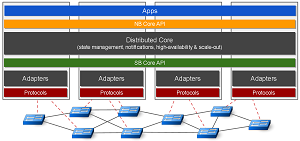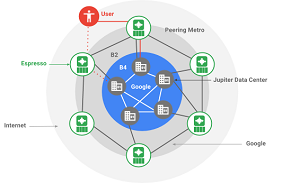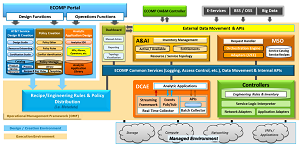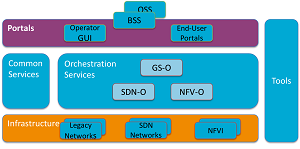News
SDN Roundup: New ONOS Offering, Google Takes It to the Edge, ONAP Code Release
Here's a look at new developments in the software-defined networking space.
The software-defined networking (SDN) space was busy during last week's Open Networking Summit, as the ONOS Project -- charged with accelerating the adoption of SDN and network functions virtualization (NFV) -- issued a new OS release, Google demonstrated its Espresso project that takes SDN to the public Internet, and the ONAP Project opened up its code and documentation.
Here's a look at recent SDN/NFV happenings:
-
ONOS Project Announces New Release of SDN Operating System
The ONOS Project unveiled the latest edition of its open source SDN operating system for service providers, a joint effort of the Open Networking Lab (ON.Lab) and the Open Networking Foundation (ONF).
ONOS said it's extending its ability to provide SDN and NFV agility to mission-critical networks by adding support for "incremental SDN" in addition to its existing "disruptive SDN" capabilities. It said disruptive SDN -- or "pure play" SDN -- utilizes white-box hardware and relies upon ONOS to provide real-time network control.
Meanwhile, the new support for incremental SDN -- or brown-field SDN -- provides software-defined configuration of legacy networking systems in which the control plane remains embedded in network devices such as Border Gateway Protocol (BGP) or the Open Shortest Path First routing protocol.
 [Click on image for larger view.]
ONOS Distributed Architecture (source: ON.Lab)
"ONOS can now import device-specific netconf/yang models, automatically manage these models in its distributed database, and dynamically sync and apply this configuration to the network," a news release stated. "Should the network devices ever fall out of sync with the configuration intent in ONOS' database, ONOS will automatically bring the network back to the desired state. In this way, centralized configuration can be organized, replicated, pushed and verified on the network, enabling ONOS to support 'incremental SDN' deployments of brown-field networking equipment alongside disruptive SDN where full control is managed by ONOS in real-time."
[Click on image for larger view.]
ONOS Distributed Architecture (source: ON.Lab)
"ONOS can now import device-specific netconf/yang models, automatically manage these models in its distributed database, and dynamically sync and apply this configuration to the network," a news release stated. "Should the network devices ever fall out of sync with the configuration intent in ONOS' database, ONOS will automatically bring the network back to the desired state. In this way, centralized configuration can be organized, replicated, pushed and verified on the network, enabling ONOS to support 'incremental SDN' deployments of brown-field networking equipment alongside disruptive SDN where full control is managed by ONOS in real-time."
Other highlighted enhancements to ONOS in the new release -- called Junco -- include:
- Whitebox Leaf-spine fabric -- the flexible datacenter fabric solution offered by ONOS has been enhanced to support IPv6 routing, vLAN tagged external interfaces and AAA endpoint authentication.
- GUI v2.0 -- an enhanced Web UI is now included, improving usability on large-scale networks by providing regional topology views with drill-down, context sensitive help, and global search.
-
Google Extends SDN to the Public Internet with Espresso
The Web giant explained the inner workings of its homegrown peering edge architecture named Espresso in a keynote presentation at the Open Networking Summit.
The company said Espresso was "the latest offering in our SDN strategy," even though it's been in production for more than two years and currently routes 20 percent of Google's total traffic to the Internet.
Other components of that strategy include Jupiter, a datacenter interconnect that can support more than 100,000 servers and 1 Pb/s of bandwidth to host Google services; B4, to connect company datacenters to one another with improved bandwidth and latency that allow the replication of data in real-time between discrete campuses; and Andromeda, an NFV stack that delivers to containers and virtual machines running on Google Cloud Platform the same capabilities available to Google-native applications.
 [Click on image for larger view.] Espresso (source: Google).
[Click on image for larger view.] Espresso (source: Google).
Meanwhile Espresso, described as the fourth -- and most challenging -- pillar of Google's SDN strategy, extends the company's approach to the peering edge of its network, where Google hooks into other networks around the globe.
In a blog post, Google explained: "Espresso delivers two key pieces of innovation. First, it allows us to dynamically choose from where to serve individual users based on measurements of how end-to-end network connections are performing in real time."
"Second, we separate the logic and control of traffic management from the confines of individual router 'boxes.' Rather than relying on thousands of individual routers to manage and learn from packet streams, we push the functionality to a distributed system that extracts the aggregate information. We leverage our large-scale computing infrastructure and signals from the application itself to learn how individual flows are performing, as determined by the end user's perception of quality."
Google said Espresso was developed internally because it found existing Internet protocols lacking in respect to supporting all of the varied options for connecting to its ISP partners through one of the largest peering surfaces in existence. It exchanges data with ISPs at 70 metros and generates more than 25 percent of all Internet traffic, the company said.
-
Open Network Automation Platform Project Releases Code, Documentation
The ONAP Project reportedly "brings together top global carriers and vendors with the goal of allowing end users to automate, design, orchestrate and manage services and virtual functions."
 [Click on image for larger view.] ECOMP Components (source: AT&T).
[Click on image for larger view.] ECOMP Components (source: AT&T).
Under The Linux Foundation umbrella organization, the young project was recently formed to combine two open networking and orchestration projects -- open source ECOMP and the Open Orchestrator Project (OPEN-O) -- with the goal of developing a unified architecture and implementation while supporting collaboration across the open source community.
 [Click on image for larger view.] OPEN-O Architecture (source: OPEN-O).
[Click on image for larger view.] OPEN-O Architecture (source: OPEN-O).
During last week's summit, the ONAP Project said it released its source code and documentation to the open source community in order to increase collaboration.
"We're excited to see how developers and others in the industry contribute to the ONAP code," said exec Chris Rice at AT&T Labs. "Today is an important day for ONAP and open networking. Collaboration is key in open source projects and we're looking forward to the community's efforts to harden the production-ready code."
That production-ready code is available here.
The ONAP Project also introduced newly elected officers and announced additional members.
About the Author
David Ramel is an editor and writer at Converge 360.